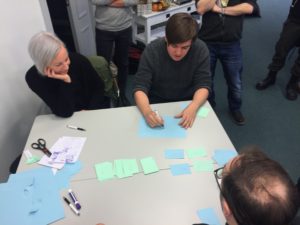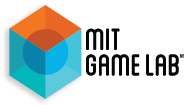Roles We Can Fit In – Recasting The Player Workshop in Stockholm

Over the past several years, the Game Lab has hosted a number of workshops with game developers, critics, and academics with the goal of developing games that center more diverse roles and playstyles. This year, we took our workshop on the road and traveled to Stockholm, Sweden for a two-day intensive jam session with our new friends at DICE, King, MAG Interactive, and Stunlock Studios. Our mission: bring together developers interested in designing for diversity and inclusivity, and make some quick paper prototypes to envision what those games might look like.
We held the workshop on January 11th and 12th at Smådalarö Gård in the Stockholm archipelago – the perfect site for a murder mystery, we joked as we stepped off the bus. We began the day by posing a challenge to our participants: how might we design games around roles and mechanics that create space for underrepresented groups? How can we create games not only diverse in terms of representation, but also in terms of the mechanics and playstyles they accommodate? To help kickstart some ideas, our two graduate research assistants, Kaelan Doyle Myerscough and Andrew Martinez, presented their own work on diversity in video games. We then split off into groups to play two co-operative card games – Hanabi and The Grizzled – that use co-op mechanics to create interesting play experience qualities. Finally, we organized participants into the design teams they would work with for the remainder of the workshop.
To get the teams started, we invited each participant to (anonymously) write down two pieces of info on separate cards:
- A skill they’ve learned (like writing, drawing, or knitting); and
- A trait about themselves (like sensitivity to sunlight).
We mixed the cards, handed two skills and two traits to each team, and challenged them to design a game around as many of the cards as they could. Some of the trait cards included “perfectionist” and “nail-biting as an anxious habit,” while the skill cards included “drawing,” “cooking” and “packing items efficiently.” Teams got down to business prototyping their games for a couple of hours before dinner at the hotel restaurant. After dinner we regrouped to play more games before bed.
The next day, we woke up bright and early to prototype our games, and finally reconvened around lunchtime for playtesting. All four games we produced involved some sort of co-op mechanic, though most of them also involved an element of competition. One common theme was communication: several of the games required players to co-operate to win, but limited their ability to communicate information. Other games involved playing with difficult handicaps, like having to draw a picture with your non-dominant hand or to communicate an idea in less than ten words. Participants particularly noted the challenge of developing games according to the trait cards. Sometimes, it was tempting to ignore the cards and focus on designing a fun game. But the groups focused on their design challenge, and the results were games that felt interesting and different to play.
 In the game “Not the Iron Chef,” players compete to create the best dish for a judge, constrained by the cost of each ingredient. In the process of selecting ingredients, players engage in cooperation, competition and bluffing.
In the game “Not the Iron Chef,” players compete to create the best dish for a judge, constrained by the cost of each ingredient. In the process of selecting ingredients, players engage in cooperation, competition and bluffing.

In “Virtuoso,” a team of three players is given three words – one each of a subject, location and verb. Without communicating verbally, the players take turns contributing to a drawing of the three words in a limited time. When they are finished they give the drawing to a fourth player, who must guess what the words were. As the game progresses, the artists are given constraint cards that limit their ability to draw effectively – for example, one card required the artist to draw with their eyes closed, while another forced them to draw without lifting their pen from the page.
Perhaps the best outcome from the workshop was the network that grew out of the design groups. Participants exchanged contact info, organized follow-up meetings, and talked late into the night and throughout the next day about current issues in games and games culture. It can be difficult in the games industry to find like-minded people who are passionate about making more diverse games, and there is always strength in numbers. We hope that participants brought back not only their design insights, but new friendships and professional contacts as well.
This post was written by workshop facilitator Kaelan Doyle Myerscough, with some input and additions by the project leader Mikael Jakobsson. Photos by Rik Eberhardt & Mikael Jakobsson. This workshop was a collaboration between the Swedish Games Industry and MIT Game Lab. Thank you to SGI and all our participants!
